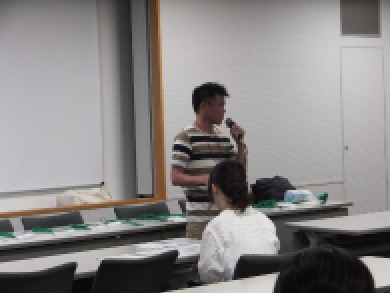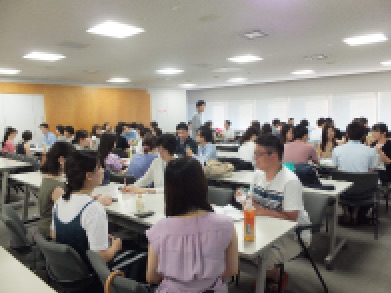1. マテリアルの紹介 Mさん

2.ディスカッション中の様子

:::::::::::::::::::::::::::::::::::::::::::::::::::::::::::::::::::::::::::::::
《 今回のworkshop 》
○workshop参加人数:66名(うち新人の方:12名)
○【前半】:”Safety is not a chance but a choice”
○【後半】:”Tattoos in onsens”
:::::::::::::::::::::::::::::::::::::::::::::::::::::::::::::::::::::::::::::::::
[今週のマテリアル]
≪FIRST HALF≫
Safety is not a chance but a choice
What do you think of your safety?
It is an opportunity to discuss it because of Osaka north area earthquake at the morning on 18th June.
Let us discuss safety in familiar situation as well as in disaster.
Q1
What were you doing at the moment of that earthquake?
How did you react against shaking?
(If you didn’t encounter quake, what did you do after you knew that incident?)
Q2
How did people around you look?
Did their reaction affect yours?
Q3
Have you taken any preventive measures to earthquake?
Were they effective in that time?
If not, did you come up with another idea reflected this experience?
Q4
Safety will be made by reducing risk to acceptable level.
I’d like you to work on KYT(Kiken Yochi(危険予知) Training)
If you have driver’s license, you might have experienced in the class.
Procedure
1. Look at the attached picture. They are carrying heavy cabinet with a cart.
2. Share the potential risks in this situation. What dangerous situations could be caused by the risks?
3. What do you do to remove the dangerous factor?
4. Discuss and decide the most unacceptable risk and preventive action against it.
≪LATTER HALF≫
<Agenda>
Tattoos in onsens
With this article, we can think about different attitudes toward tattoos and think about how to balance these attitudes in situations with people from multiple cultures.
<Questions>
1. What do you think of allowing people with tattoos to enter onsens?
2. Do you think these changes will happen, or will the rules continue in the same way?
3. What affect would the change have on onsen business and the people who visit them?
4. Should rules be the same for locals and foreigners, or should there be different rules?
5. The video compares traditional, simple onsens and modern, luxurious versions. Which do you prefer, and why?
6. How do you feel about tattoos? What attitudes toward tattoos have you experienced in the places where you’ve traveled or the people you’ve talked to?
7. Which onsens or foot bath locations do you recommend?
<Phrases>
・body art – another term for tattoo
・unspoken etiquette – rules that aren’t directly written, but people follow
・closely dictates – controls
・every stitch of clothing – absolutely all clothing
・issued reassurances – sent messages to make them feel safe
<References>
https://edition.cnn.com/travel/article/japan-hot-spring-tourists-tattoo-rules/index.html
This article is from an American news site.
Japan’s hot springs asked to allow tattooed foreigners
See the website for the video.
Article text:
Naked, tattooed foreigners may soon become a less unusual sight in Japan’s public baths.
Tourism officials in Japan are urging onsens (hot springs) to relax rules restricting body art wearers from entering their steamy waters. Traditional onsens have long been governed by an unspoken etiquette that closely dictates behavior:
— Bodies must be carefully washed before entering.
— Every stitch of clothing must be removed. Even towels.
— And tattoos are considered unacceptable.
Traditional Japanese tattoos, which cover large swaths of skin, are commonly associated with the yakuza, the country’s organized crime syndicates. And people with body art are often turned away for fear of scaring off others looking for a quiet soak or a restorative ritual.
Now the Japan Tourism Agency has asked for the rules to be relaxed for foreigners as visitor numbers to the country continue to rise.
“We don’t put up ‘no tattoo’ signs, but we do ask them to refrain from using our baths if their tattoos cover large parts of their bodies and can’t be concealed by a sticker,” a manager at Yamagishi Ryokan, a hot spring in Yamanashi prefecture popular with foreign tourists, tells CNN.
“We treat locals with tattoos the same way we treat foreigners. But no Japanese covered in tattoos has tried to come in — I believe they’re totally aware of the rules.”
The official guidance, released last week, suggests asking patrons to cover their tattoos with a sticker or use a private bath.
Seeking to improve awareness, the agency has issued reassurances to bath owners. It explained that there are often religious, cultural, aesthetic or other choices behind the body modification practice and the ink doesn’t pollute the baths.
CNN’s Junko Ogura contributed to this report, originally published in March 2016.
***********************************************************
私たちと一緒に英語コミュニケーション能力を鍛えませんか?
ご興味を持たれた方は、
入会申込フォーム
https://english-speaking-club.com/cms/?page_id=93
よりお申し込みください。お待ちしています!
***********************************************************